

Archaeologists unearth the oldest adobe architecture in the Americas. (the “Website”), is operated by HERITAGEDAILY What are cookies?
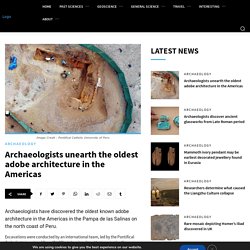
Cookies are small text files that are stored in the web browser that allows HERITAGEDAILY or a third party to recognise you. Cookies can be used to collect, store and share bits of information about your activities across websites, including on the HERITAGEDAILY website and subsidiary brand website. Cookies can be used for the following purposes: – To enable certain functions – To provide analytics – To store your preferences – To enable ad delivery and behavioural advertising HERITAGEDAILY uses both session cookies and persistent cookies.
A session cookie is used to identify a particular visit to our Website. A persistent cookie will remain on your devices for a set period of time specified in the cookie. How do third parties use cookies on the HERITAGEDAILY Website? Third party companies like analytics companies and ad networks generally use cookies to collect user information on an anonymous basis. Researchers present evidence that a cosmic impact destroyed a biblical city in the Jordan Valley. In the Middle Bronze Age (about 3600 years ago or roughly 1650 BCE), the city of Tall el-Hammam was ascendant.

Located on high ground in the southern Jordan Valley, northeast of the Dead Sea, the settlement in its time had become the largest continuously occupied Bronze Age city in the southern Levant, having hosted early civilization for a few thousand years. At that time, it was 10 times larger than Jerusalem and 5 times larger than Jericho. “It’s an incredibly culturally important area,” said James Kennett, emeritus professor of earth science at the UC Santa Barbara. Maya neighbourhood designed to look like Teotihuacan discovered at Tikal. (the “Website”), is operated by HERITAGEDAILY What are cookies?
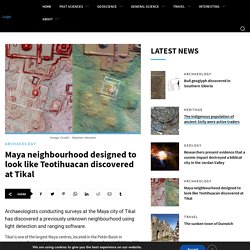
Cookies are small text files that are stored in the web browser that allows HERITAGEDAILY or a third party to recognise you. Cookies can be used to collect, store and share bits of information about your activities across websites, including on the HERITAGEDAILY website and subsidiary brand website. If the Flintstones Vacationed in France: A Guide to the Cave Villages. Ultimate Basement Find: A City. Ucp007 006 007. Photo Gallery: Sneaking into Hitler's Bunker. Tracking: We work with third party providers to improve and finance our web products.

Together with these third-party providers, we collect and process personal data on our platforms. Using cookies stored on your device, personal identifiers such as device identifiers or IP addresses, and based on your individual usage patterns, together with these third party providers we can ... ... Store and/or retrieve information on a device: For the processing purposes disclosed to you, cookies, device identifiers or other information may be stored or accessed on your device.... Execute personalized ads and content, ad and content measurement, audience and product development insights: Ads and content can be personalized based on a profile.
You also consent to your data being processed by providers in third countries and the United States. 11 Things Buried Under Parking Lots. With the 20th-century rise of the automobile, there came a new demand on city land to give those cars a place to park.
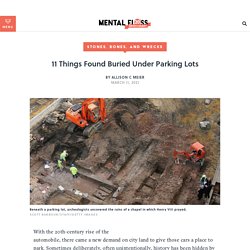
Sometimes deliberately, often unintentionally, history has been hidden by these stretches of concrete. Here's a look at some amazing items found buried under parking lots, from the bones of an infamous king to a magician’s curse. Noushabad – The Hidden Underground City. Noushabed, also called Oeei or Ouyim is an ancient subterranean city, built beneath the small town of Nushabad in present-day Iran.
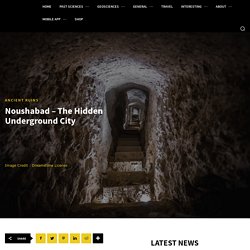
The earliest parts of the city were constructed sometime during the Sassanid period between AD 224 to 651 and continued to be excavated during the post-Islamic era, with evidence of occupation lasting until the Qajar dynasty. Archaeologists have discovered human remains, earthen vessels, and stone instruments from the Sassanian, Ilkhanid, and Safavid periods, suggesting almost continuous use for many centuries. Researchers have identified three distinct levels reaching a depth of 16 metres, and a complex network of interconnected tunnels and chambers covering an area of 3.7 acres. The Ancient City of Termessos.
Termessos was a fortified city, founded by Pamphylian tribes called the Solymi (also called the Solims) near the peak of the Solymos (Güllük Dağı) mountain, in the Taurus mountain range in present-day Turkey.
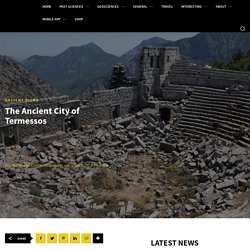
Archaeologists Uncover ‘Fast Food’ Counter at Pompeii. Archaeologists conducting excavations at the Thermopolium of Regio V in the Roman city of Pompeii have revealed an ancient ‘fast food’ counter.
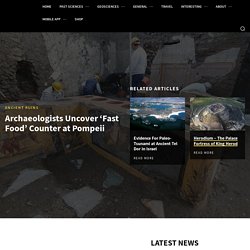
Pompeii was a Roman city, located in the modern commune of Pompeii near Naples in the Campania region of Italy. Pompeii, along with Herculaneum and many villas in the surrounding area was buried under 4 to 6 m (13 to 20 ft) of volcanic ash and pumice in the eruption of Mount Vesuvius in AD 79. At its peak, Pompeii had a population of around 20,000 inhabitants and became an important passage for goods that arrived by sea to be sent toward Rome or Southern Italy along the nearby Appian Way. Geoscientists Discover Ancestral Puebloans Survived From Ice Melt in New Mexico Lava Tubes. For more than 10,000 years, the people who lived on the arid landscape of modern-day western New Mexico were renowned for their complex societies, unique architecture and early economic and political systems.

But surviving in what Spanish explorers would later name El Malpais, or the “bad lands,” required ingenuity now being explained for the first time by an international geosciences team led by the University of South Florida. Exploring an ice-laden lava tube of the El Malpais National Monument and using precisely radiocarbon- dated charcoal found preserved deep in an ice deposit in a lava tube, USF geosciences Professor Bogdan Onac and his team discovered that Ancestral Puebloans survived devastating droughts by traveling deep into the caves to melt ancient ice as a water resource. “The melting cave ice under current climate conditions is both uncovering and threatening a fragile source of paleoenvironmental and archaeological evidence,” he added.
Göbekli Tepe. Neolithic archaeological site in Turkey First noted in a survey in 1963, the importance of the site was recognised by Schmidt, who directed excavations there from 1995 until his death in 2014.
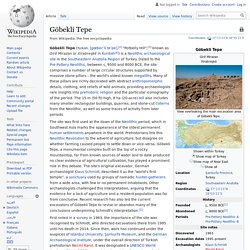
Since then, work has continued under the auspices of Istanbul University, Şanlıurfa Museum, and the German Archaeological Institute, under the overall direction of Turkish prehistorian Necmi Karul. It was designated a UNESCO World Heritage Site in 2018, recognising its outstanding universal value as "one of the first manifestations of human-made monumental architecture".[5] As of 2021[update], less than 5% of the site has been excavated.[6] Background Göbekli Tepe was built and occupied during the Pre-Pottery Neolithic (PPN)—the earliest division of the Neolithic period in Southwest Asia—which is dated to between 9600 and 7000 BCE.
Known PPN sites in the Urfa region. PPN villages consisted of clusters of stone or mud brick houses, and sometimes substantial monumental or 'communal' buildings. Fill Art. Researchers have examined the burial mound where the Gokstad Viking ship was found. What they found surprised them. The Gokstad ship is one of the most famous Viking ships in the world. It lay almost completely in peace inside a burial mound in Vestfold for up to a thousand years. The ship was laid to rest around the year 900 AD. In 1880, the grave was opened, and archaeologists found, among other things, several smaller boats and remains of several animal victims — in addition to the 24-meter-long, very well-preserved Viking ship. Pharaoh Ramesses VI Tomb. Londinium – Roman London.
Londinium is the name given to the Roman city, now occupied by the City of London that contains the historic centre and the primary central business district of London. Unlike many Roman settlements established on existing Oppidum, there does not appear to be any prior Iron Age settlements before the Roman conquest of AD43 within the Roman city limits.
Several fortified Iron Age hillforts and enclosures are evident in the greater London area, like those at Wimbledon and Epping Forest, possibly attributed to either the Trinovantes or Catuvellauni tribes. 'Extraordinary' Roman villa reopened to public in Herculaneum. An ancient Roman house has reopened to the public in the archaeological park of Herculaneum, the town near Naples buried by the eruption of Mount Vesuvius in AD79. Considered the site’s most noble Roman villa, the House of the Bicentenary had been under restoration for 35 years. The three-storey, 600 sq metre domus, which contains stunning frescoes and mosaic floors, was discovered in 1938, 200 years after excavations at the site began, but closed to the public in 1983 after falling into disrepair. “This is an important result,” Dario Franceschini, the Italian culture minister, said during a ceremony to open the home on Wednesday.
“An extraordinary monument, which had fallen into a state of neglect, is again accessible to visitors.” "The Works of The Old Men" Are Unexplained Structures in the Middle Eastern Desert. There are lots of good reasons to believe this is how things went down. For one thing, rock art found in some areas with a plentitude of kites depicts gazelles being slain in exactly that fashion, and researchers think that art suggests the slaughter wasn't purely for food. Instead, they may have been planned to commemorate spiritually significant events — you know, kind of like how you blow out candles on your birthday. Only it's an entire species of gazelle. Aren't humans great? Roman Forts & Fortlets of the Antonine Wall - Interactive Map. Antone Wall Map – Hadrian’s Wall is generally thought of as the northernmost border of the Roman Empire in Britannia, but the Romans actually pushed further north into Scotland and built another wall, the Antonine Wall.
Construction of the wall began in AD 142 under the orders of Emperor Antoninus Pius, and ran across the central belt of Scotland between the Firth of Forth and the Firth of Clyde. The wall was mainly a turf fortification placed on stone foundations, 3 metres high and 5 metres wide. This Is What The Forgotten 7 Wonders Of The Ancient World Really Looked Like In Their Prime. What is the first thing you do before planning a trip? Hop on the convenient TripAdvisor or one of thousands other websites available for advice, must-see destinations, trip highlights and candid travelers’ photos. Pompeii ‘fast food’ bar unearthed in ancient city after 2,000 years. Viking homes were stranger than fiction: portals to the dead, magical artefacts and ‘slaves’ This Roman Bathhouse Was Built Over 2,000 Years Ago And Is Still Up And Running. Hidden history of Rome revealed under world's first cathedral.
Watch These Cool GIFs Restore Ancient Ruins to Their Former Glory. First evidence for Julius Caesar's invasion of Britain discovered - HeritageDaily - Heritage & Archaeology News. How Researchers Uncovered a Massive Void in the Great Pyramid of Giza. 7 Ancient Long Barrows in England - HeritageDaily - Heritage & Archaeology News. A long barrow is a prehistoric monument dating to the early Neolithic period. They are rectangular or trapezoidal tumuli or earth mounds traditionally interpreted as collective tombs. 1 : West Kennet Long Barrow. Ancient data, modern math and the hunt for 11 lost cities of the Bronze Age. Sciencemag. The farming town of Broo on Scotland’s Shetland Islands was no stranger to extreme weather. Located on an archipelago just south of the Arctic Circle, its inhabitants had braved lashing winds and bitter cold winters. But it was something else that did Broo in: sand. Mexico Is Hiding The World’s Largest Pyramid.
Mysterious Earthen Mounds Discovered in Ancient Cambodian Cities. Using airborne laser-scanning equipment, archaeologists have discovered vast fields of dome-shaped earthen mounds, arranged into gridded patterns, in 1,000-year-old Cambodian cities. The scientists are puzzled as to what these vast "dome fields" (as archaeologists sometimes call them) would have been used for around 1,000 years ago, calling them "the most enigmatic features" from this archaeological landscape. In addition to the dome fields, archaeologists also found mounds shaped into geometric patterns, such as spirals. These geometric features are located near Cambodian temple complexes, including examples found near Angkor Wat.
Evidence of Sophisticated, Ancient, Unknown Cultures in North America....Page 38. Photo: Burnt Hill Site-Western Massachusetts, by Colgate Gilbert Mystery Hill, the Upton Cave, Calendar I and Calendar II, Gungywamp and Druid’s Hill are just several of the names given some incredibly important historical sites of which many have never heard a whisper. But their existence—and their importance—is becoming harder and harder to hide as more are discovered and interested folk become exposed to their grandeur. Sometime in the late 1600s or early 1700s, early American colonists began discovering and utilizing underground "root cellars" made of large, but manageable pieces of dressed stone as storage houses for food stuffs. Travel - The mystery of England’s ancient tunnels. “How do you like spiders?” Asked James Gossip, an archaeologist, British prehistory expert and my guide to this subterranean world – one, apparently, that’s already inhabited. Ancient Pompeii Is Alive Again as Italian Officials Unveil Six Restored Ruins.
Mesa Verde: Cliff Dwellings of the Anasazi. Thermal Scans Of Egypt's Great Pyramid Reveal 'Impressive' Anomaly. Mysterious Symbols in Kazakhstan: How Old Are They, Really? NASA Adds to Evidence of Mysterious Ancient Earthworks. Prehistoric Village Of 'National Significance' Unearthed Amid Miami Skyscrapers. Photos: The Secret Passageways of Hadrian's Villa. 'Secret' Labyrinth of Tunnels Under Rome Mapped. An ancient city thought lost is exhumed from the depths of the ocean. Robot discovers three unexplored passages in 2,000-year-old tunnel near the Pyramid of the Sun in Mexico.
A French-Peruvian-Spanish Team Discovers a Chamber in Machu Picchu. Privacy hedges date back to the Iron Age. Labyrinth Lies Within Mysterious Desert Drawing. Lines in the sand may have been made for walking. Pre-Viking hotspot on the Norwegian Coast. Russian Geoglyph: Elk-Shaped Design Found In Ural Mountains, May Predate Peru's 'Nazca Lines' Göbekli Tepe. First Ever Etruscan Pyramids Found in Italy. Roman Fort That Helped Julius Caesar Conquer Gaul Identified In Germany. The English inspired Vikings to build cities. Herders, Not Farmers, Built Stonehenge.